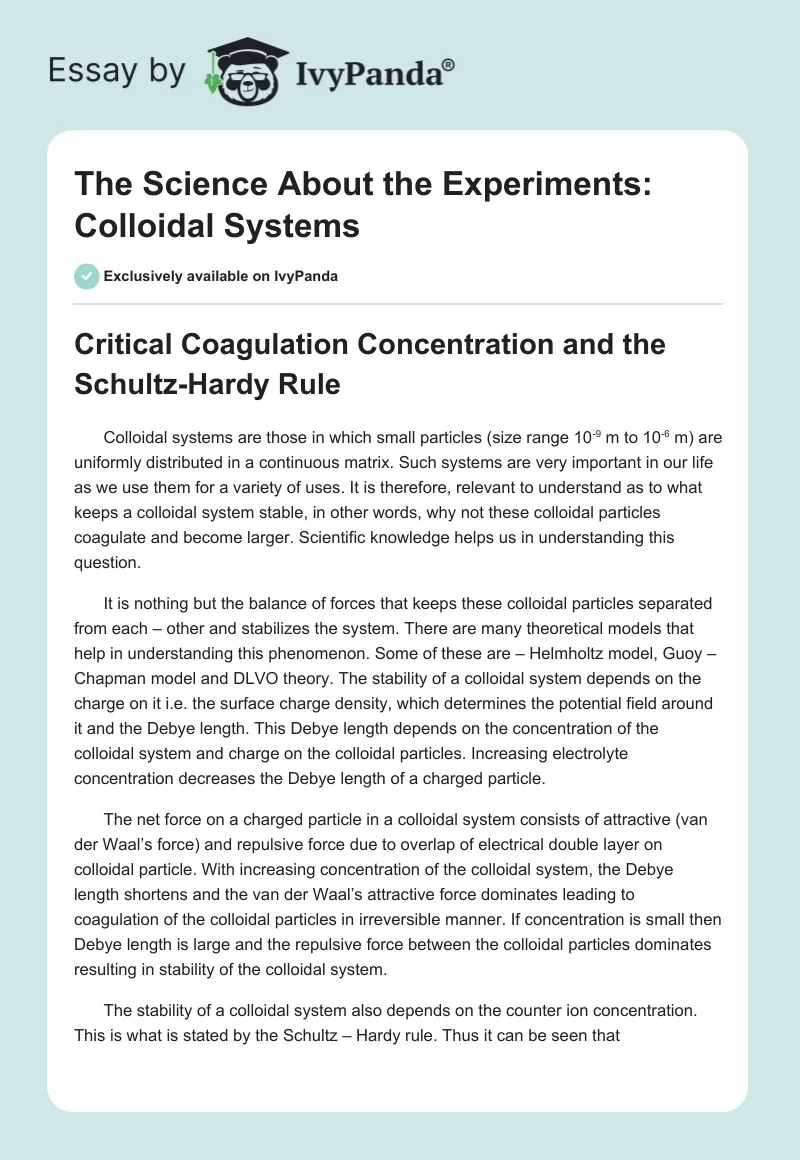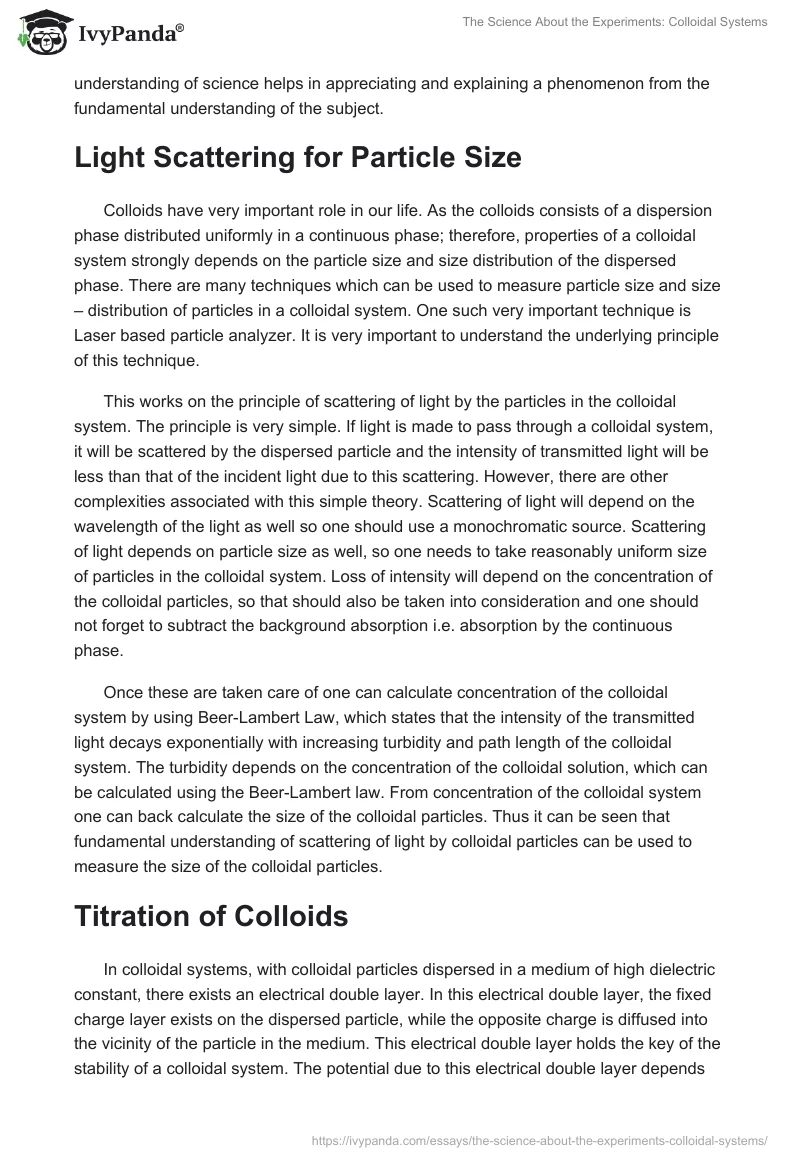Critical Coagulation Concentration and the Schultz-Hardy Rule
Colloidal systems are those in which small particles (size range 10-9 m to 10-6 m) are uniformly distributed in a continuous matrix. Such systems are very important in our life as we use them for a variety of uses. It is therefore, relevant to understand as to what keeps a colloidal system stable, in other words, why not these colloidal particles coagulate and become larger. Scientific knowledge helps us in understanding this question.
It is nothing but the balance of forces that keeps these colloidal particles separated from each – other and stabilizes the system. There are many theoretical models that help in understanding this phenomenon. Some of these are – Helmholtz model, Guoy – Chapman model and DLVO theory. The stability of a colloidal system depends on the charge on it i.e. the surface charge density, which determines the potential field around it and the Debye length. This Debye length depends on the concentration of the colloidal system and charge on the colloidal particles. Increasing electrolyte concentration decreases the Debye length of a charged particle.
The net force on a charged particle in a colloidal system consists of attractive (van der Waal’s force) and repulsive force due to overlap of electrical double layer on colloidal particle. With increasing concentration of the colloidal system, the Debye length shortens and the van der Waal’s attractive force dominates leading to coagulation of the colloidal particles in irreversible manner. If concentration is small then Debye length is large and the repulsive force between the colloidal particles dominates resulting in stability of the colloidal system.
The stability of a colloidal system also depends on the counter ion concentration. This is what is stated by the Schultz – Hardy rule. Thus it can be seen that understanding of science helps in appreciating and explaining a phenomenon from the fundamental understanding of the subject.
Light Scattering for Particle Size
Colloids have very important role in our life. As the colloids consists of a dispersion phase distributed uniformly in a continuous phase; therefore, properties of a colloidal system strongly depends on the particle size and size distribution of the dispersed phase. There are many techniques which can be used to measure particle size and size – distribution of particles in a colloidal system. One such very important technique is Laser based particle analyzer. It is very important to understand the underlying principle of this technique.
This works on the principle of scattering of light by the particles in the colloidal system. The principle is very simple. If light is made to pass through a colloidal system, it will be scattered by the dispersed particle and the intensity of transmitted light will be less than that of the incident light due to this scattering. However, there are other complexities associated with this simple theory. Scattering of light will depend on the wavelength of the light as well so one should use a monochromatic source. Scattering of light depends on particle size as well, so one needs to take reasonably uniform size of particles in the colloidal system. Loss of intensity will depend on the concentration of the colloidal particles, so that should also be taken into consideration and one should not forget to subtract the background absorption i.e. absorption by the continuous phase.
Once these are taken care of one can calculate concentration of the colloidal system by using Beer-Lambert Law, which states that the intensity of the transmitted light decays exponentially with increasing turbidity and path length of the colloidal system. The turbidity depends on the concentration of the colloidal solution, which can be calculated using the Beer-Lambert law. From concentration of the colloidal system one can back calculate the size of the colloidal particles. Thus it can be seen that fundamental understanding of scattering of light by colloidal particles can be used to measure the size of the colloidal particles.
Titration of Colloids
In colloidal systems, with colloidal particles dispersed in a medium of high dielectric constant, there exists an electrical double layer. In this electrical double layer, the fixed charge layer exists on the dispersed particle, while the opposite charge is diffused into the vicinity of the particle in the medium. This electrical double layer holds the key of the stability of a colloidal system. The potential due to this electrical double layer depends on the surface charge density of the colloidal particle. Therefore, it is important to experimentally determine this. This can be determined by titrating a colloidal system with a salt or an electrolyte. Addition of salts reduces the surface charge density on a colloidal particle and therefore, there is a concentration of the added salt for which a colloidal system can be brought to its position of zero charge or PSZ. From the concentration of the salt required to bring a sol to its position f zero charge one can calculate the surface charge density on a colloidal particle.
Thus it can be seen that scientific understanding helps in designing simple experiments to demonstrate understanding of apparently complex processes.
Surface Tension and Contact Angle
Surface tension of a material is macroscopic manifestation of a microscopic property of a material – inter-atomic or intermolecular forces in that material. In case of solids, this property is more often termed as surface energy i.e. energy required to create a new surface. In case of liquids both the terms – surface energy as well as surface tension is used. This discussion is limited to liquids only. In any liquid, there are attractive forces between atoms / molecules that keep the liquid together. Due to these attractive forces, the liquid tries to assume a shape which maximizes the number of bonds between the atom / molecules in the liquid. This is the reason, why a water drop or for that matter drop of any liquid assumes a spherical shape, if allowed to as this shape maximizes the number of bonds between the molecules of water. However, the atoms on the surface – which is essentially a two phase interface between water and air, have molecules with un-satiated intermolecular bonds. This is what causes surface tension. Thus higher the inter atomic / intermolecular force higher will be the surface tension. This is why water has higher surface tension than organic fluid like hexane as inter atomic force in case of water is hydrogen bond, which is much stronger than the van der Waal’s forces attracting the hexane molecule.
Once the water droplet is kept onto some other surface, now there are competitive forces at work, theses are attractive force between water molecules and the attractive force between water molecule and the new material. If the formal is stronger, then water will prefer to assume a shape in which the contact with the new surface is minimum and the contact angle will be large; however, if the latter is stronger, then water will prefer to bond with more of the new surface than with itself and the contact angle will be small.
Thus contact angle is a result of the interplay between the cohesive force of a liquid and the adhesive force between the liquid and the solid material at the interface. Similarly, if the surface tension is small, then a liquid will rise higher in a capillary tube. Thus it can be seen that how scientific understanding of intermolecular forces helps in explaining the phenomena like contact angles and rise of a liquid in a capillary tube.
Critical Micelle Concentration (CMC) of Surfactants
There are some organic molecules with amphiphilic characteristics. These molecules have two parts – head and tail and the two parts have opposite polarity. Such molecules are soluble in water to some extent so as to form a monolayer on the free surface of water. This leads to considerable drop in surface tension of water. Sue to this reason, these molecules is termed as surfactant. Decrease in the surface tension of water is a logarithmic function of surfactant concentration. Once the concentration of surfactant reaches to the critical value, i.e. when all the available free surface or water – air surface is covered by monolayer of surfactant there is no incremental decrease in surface tension of water due to further addition of the surfactant. The additional surfactant added to water forms structures of colloidal dimensions and the resultant colloid is termed as micelles.
How to determine the critical micelles concentration? One technique could be measuring the surface tension of water with varying concentration of the surfactant molecules and the critical micelles concentration will be given by the saturation is decreasing surface tension vs. surfactant concentration plot.
Another way could be measuring the conductivity of water with varying concentration of the surfactant molecules. As the monomer ions will have higher mobility than the micelles; therefore, concentration of the solution will increase with increasing concentration of surfactant until micelles starts to form leading to decrease in the conductivity.
Thus it can be seen that basic scientific understanding helps in determining critical micelle concentration of surfactants.


